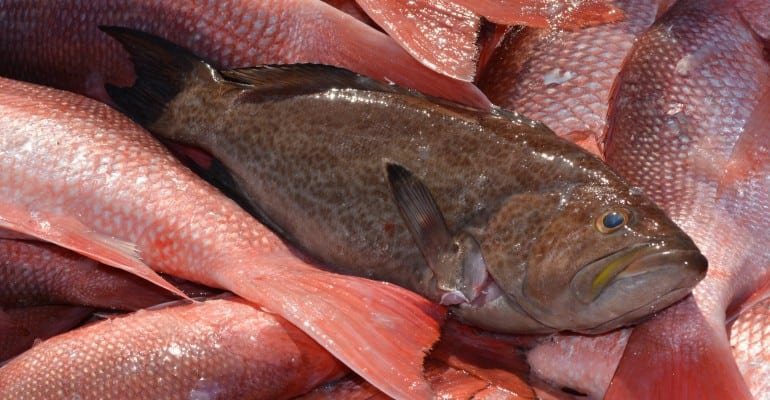| FORMAL FEDERAL REGISTER NAME/NUMBER: 87 FR 74014, published December 2, 2022
Frequently Asked Questions
Why are the Gulf red snapper catch limits increasing?
- Two red snapper interim analyses, completed in 2021, indicated that catch levels could be increased.
- One of the analyses used the results from the Great Red Snapper Count in 2021, which estimated stock biomass of Gulf red snapper was approximately three times the previous estimate. The other analysis used information from the NOAA Fisheries’ Bottom Longline survey.
- The Gulf of Mexico Fishery Management Council’s Scientific and Statistical Committee reviewed results of both of these analyses at its March 30 – April 2, 2021, meeting.
- Based on this information, the Scientific and Statistical Committee recommended an increase in the red snapper annual catch limits.
Why will the OFL increase by so much (10.1 million pounds) but the ABC only has a small (0.3 million pounds) increase?
- During its March – April 2021 meeting, the Gulf of Mexico Fishery Management Council’s Scientific and Statistical Committee reviewed the Great Red Snapper Count project report, supporting documentation, and findings of independent consultants.
- The Great Red Snapper Count indicated that the number of red snapper was estimated to be approximately three times greater than estimated in the most recent stock assessment, SEDAR 52.
- The Committee discussed that the estimates of red snapper from the Great Red Snapper Count and SEDAR 52 were similar for hard bottom and artificial reef habitat where most fishing occurs for the species.
- The Great Red Snapper indicated that red snapper also inhabit uncharacterized bottom, which was largely not considered in previous stock assessments for red snapper. This represents the primary driver in the difference in abundance estimates between the SEDAR 52 stock assessment and the Great Red Snapper Count.
- The Committee noted that because red snapper occur at relatively low densities over uncharacterized bottom compared to known hard bottom (including artificial reefs, etc.), they are unlikely to be targeted in these areas.
- Because red snapper occupying uncharacterized bottom have historically faced lower fishing mortality than hard bottom, basing harvest levels on the entire population may lead to localized depletion on reefs as the overwhelming majority of harvest would be expected to occur on this habitat.
- The Committee used results of the interim analysis that incorporated the abundance estimates from the Great Red Snapper Count to provide an OFL recommendation of 25.6 million pounds (mp) whole weight (ww). This was based on the abundance of all red snapper over structure (artificial reef, natural reef, and pipeline) and 13% of the abundance from the uncharacterized bottom.
- However, the Committee made its ABC recommendation of 15.4 mp using the results of the interim analysis that incorporated information from NOAA Fisheries’ Bottom Longline survey, with data from 2000 – 2020. The survey index showed that the highest Gulf-wide abundance of red snapper was in 2016 and has declined since.
- The Committee concluded that the red snapper ABC should be considerably more conservative than the OFL due to the uncertainties in the Great Red Snapper Count.
Why will the calibration ratios be implemented for the Gulf states?
- For the red snapper private angling component, each Gulf state is allocated a portion of the component’s ACL, and is responsible for constraining landings to its ACL.
- However, the current state ACLs are not all set in the same units, or currency, in which each state estimates landings.
- Because the state-specific landings are in a different currency than the current state ACLs, calibration is necessary to convert the state ACLs into the currency in which each state monitors landings. This would reduce the likelihood of exceeding red snapper catch limits including the private angling component ACL, total recreational ACL, and the OFL.
- Allowing each state to manage state landings using its own data collection system has allowed the total private recreational ACL, which is set in Federal units, to be exceeded in 2018 and 2019, and the OFL to be exceeded in 2019. When catch limits are exceeded in this manner, the Magnuson-Stevens Fishery Conservation and Management Act requires the Gulf of Mexico Fishery Management Council and NOAA Fisheries take action to prevent exceeding these limits in the future.
When will this final rule be implemented?
- The Gulf of Mexico Fishery Management Council chose an implementation date for the calibration ratios of January 1, 2023. Thus, the effective date for the changes in this rule will be January 1, 2023.
Where can I find more information on the Red Snapper Catch Limits Framework?
- Contact NOAA Fisheries, Southeast Regional Office
By Mail: Daniel Luers or Rich Malinowski
NOAA Fisheries, Southeast Regional Office
Sustainable Fisheries Division
263 13th Avenue South
St. Petersburg, Florida 33701-5505
By FAX: (727) 824-5308
By Phone: (727) 824-5305
|



